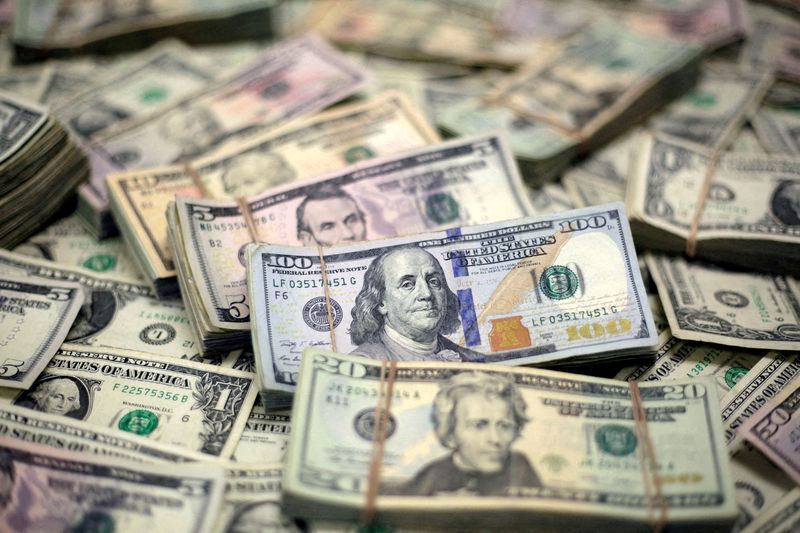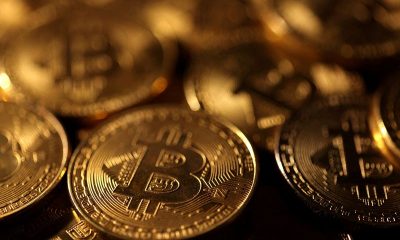Forex
Dollar rises to highs; political uncertainty spurs safe haven demand

Investing.com – The U.S. dollar climbed to new highs Wednesday, as uncertainty over U.S. interest rates and the upcoming presidential elections kept the safe haven in demand.
At 04:10 ET (08:10 GMT), the Dollar Index, which tracks the greenback against a basket of six other currencies, traded 0.3% higher to 104.175, close to a near three-month high.
Risks point to dollar upside
The dollar has climbed to its highest level since early August as reasonably healthy economic data has seen expectations for aggressive interest rate cuts from the Federal Reserve fade.
Traders were seen pricing in a 85.9% chance for a 25 basis point cut in November, and a 14.1% chance rates will remain unchanged, CME Fedwatch showed.
This change in stance has seen US Treasury yields surge on expectations of relatively higher rates, with the 10-year yield hitting a three-month high this week.
Also helping support the greenback has been the growing expectations that Republican candidate Donald Trump will win the US Presidential election earlier next month, given his protectionist policies are seen boosting the US currency.
“Key market factors continue to support the greenback. We could see some momentum fade today, but the balance of risks remains skewed to the upside into the US election,” said analysts at ING, in a note.
More ECB cuts on the way
In Europe, edged 0.1% lower to 1.0785, with the euro weakening amid growing expectations that the European Central Bank may be more aggressive in rate cuts going forward given an uncertain growth outlook.
The has already cut rates three times this year from a record high, and markets see policy easing at each of its upcoming meetings well into the new year.
The International Monetary Fund on Tuesday said the German economy, Europe’s biggest, would stagnate this year, cutting its forecast from 0.2% growth previously.
Additionally, eurozone inflation is easing and may fall back to 2% quicker than previously thought, ECB President Christine Lagarde said on Tuesday, supporting the case for further rate cuts.
fell 0.1% to 1.2969, ahead of a speech by Bank of England Governor later in the day, which could offer more clues of further monetary policy.
Bailey said in an interview earlier this month that the central bank could move more aggressively to cut interest rates if inflation pressures continue to weaken.
Since then the UK’s has fallen to 1.7% on an annual basis – the first time it had fallen below the Bank of England’s 2% target since April 2021.
“Cable can still move to 1.28 by month-end,” ING added.
Yen slumps ahead of general election
soared 0.9% to 152.38, climbing above the 152 level for the first time since July 31 with recent opinion polls indicating that the ruling Liberal Democratic Party could lose its majority with coalition partner Komeito at the weekend’s general election.
The risk of a minority coalition government has raised the prospect of political instability complicating the Bank of Japan’s effort to reduce dependence on monetary stimulus.
The BOJ is also set to meet next week, but is unlikely to hike rates. Before that, consumer inflation from Tokyo is due this Friday.
rose 0.1% to 7.1265, with the focus turning to an upcoming meeting of China’s National People’s Congress for more cues on fiscal spending.
rose 0.1% to 1.3824, ahead of the latest policy-setting meeting by the later in this session.
“Markets are pricing in 45bp of easing by the Bank of Canada today. The reasoning is that inflation has now slowed below target and a soft growth picture warrants a faster, 50bp, move to neutral rates,” said ING. “It is a very close call, but we think 25bp remains slightly more likely.”

 Forex3 years ago
Forex3 years agoForex Today: the dollar is gaining strength amid gloomy sentiment at the start of the Fed’s week

 Forex3 years ago
Forex3 years agoUnbiased review of Pocket Option broker

 Forex3 years ago
Forex3 years agoDollar to pound sterling exchange rate today: Pound plummeted to its lowest since 1985

 Forex3 years ago
Forex3 years agoHow is the Australian dollar doing today?

 Cryptocurrency3 years ago
Cryptocurrency3 years agoWhat happened in the crypto market – current events today

 World3 years ago
World3 years agoWhy are modern video games an art form?

 Commodities3 years ago
Commodities3 years agoCopper continues to fall in price on expectations of lower demand in China

 Economy3 years ago
Economy3 years agoCrude oil tankers double in price due to EU anti-Russian sanctions

























